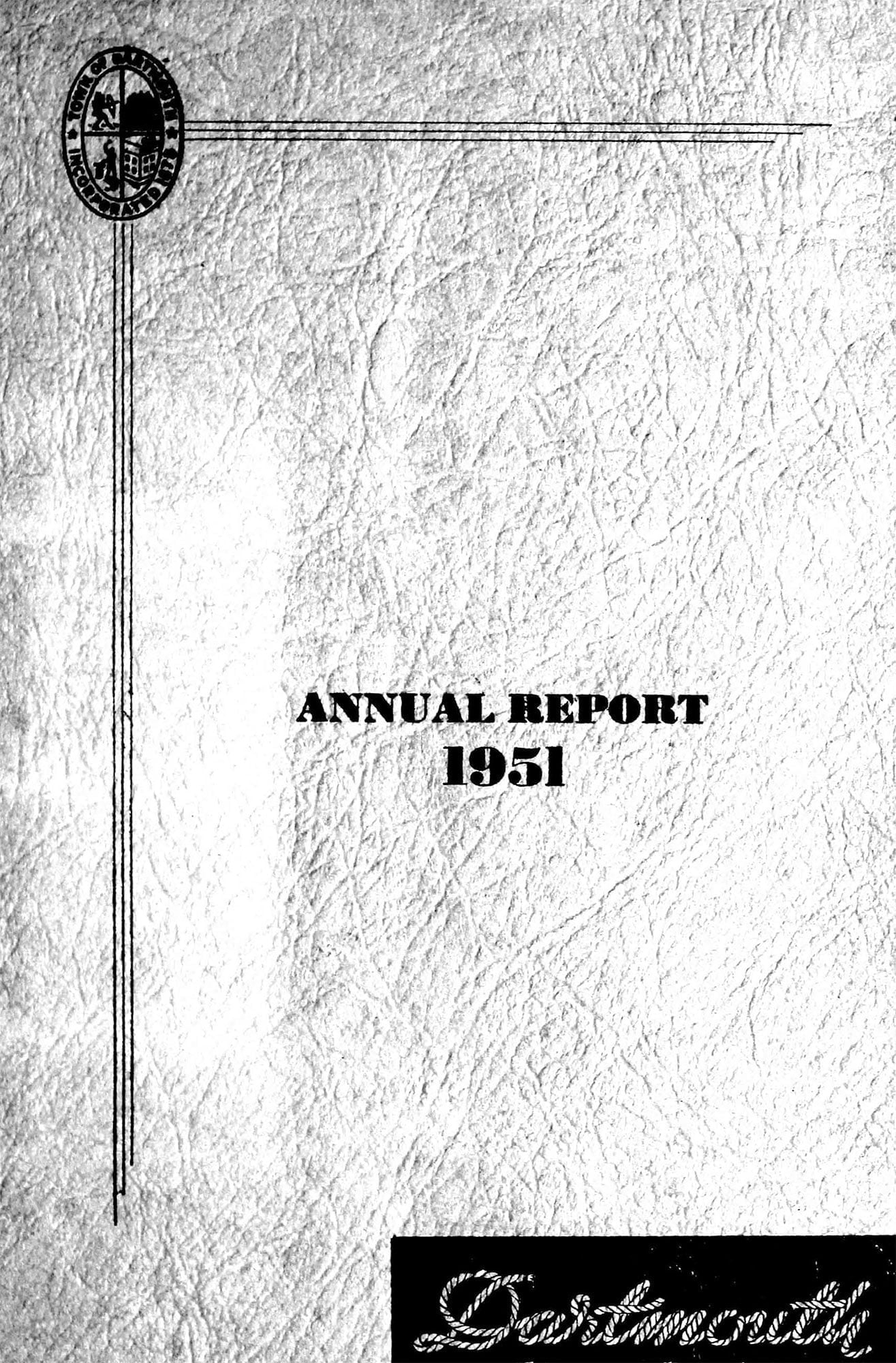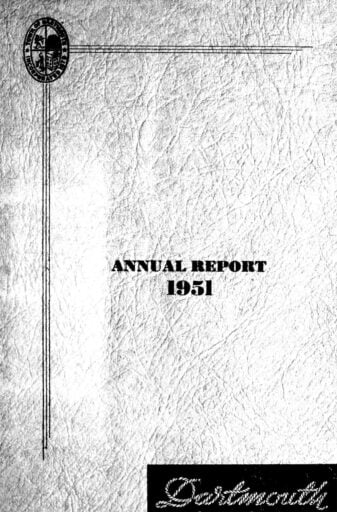
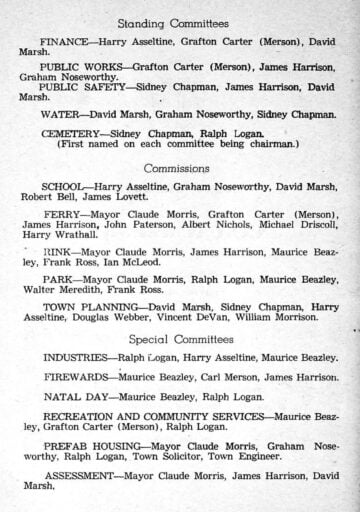
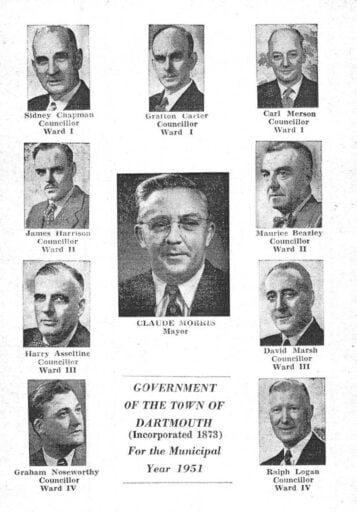
The Mayor’s Report
Citizens of Dartmouth, Ladies and Gentlemen:
I have the honor to submit my report as Mayor of the year 1951. The year just closed marked another year of progress for Dartmouth, one in which the official census figures showed a population in excess of 15,000, an increase of 40 percent over the 1941 census.

During the year 1951 we marked the completion of our new Junior High School, which is widely acclaimed as the most modern in its field, and also observed the official opening of the Dartmouth Memorial Rink. Both of these were in. operation during the year and are filling a long-felt need in the Town. An addition to Notting Park Elementary school was also started late in the year.
Good progress was made in the special water project involving the construction of a reservoir outside the Town. Further progress was also made in the Windmill Road widening project. Both of these undertakings are scheduled for completion in 1952.
The Harbour Bridge came a step nearer with the expropriation of land by the Bridge Commission and the removal of many homes from the site.
Curb, gutter and sidewalk work was slowed somewhat due to credit restrictions as was new housing, however, business expansion continued with the completion of the Dominion Store and the Wool-worth building. Building by-laws were approved and are now available in a convenient booklet.
Debenture issues by the Town were very well received; we continue to enjoy an excellent reputation in financial circles. The re-assesment survey started in January was completed ahead of schedule, raising our assessments to approximately $21,000,000.
For the first time in history, Town elections were held on the first Tuesday in December with the newly elected members of Council taking office on January first. These elections were marked by the election of our first lady councillor.
Two hundred and fourteen prefabricated houses were purchased from the Central Mortgage and Housing Corporation at $1000 each and were permanized by placing concrete foundations under them and making ether repairs at an additional cost of approximately $1000 per house. These houses were offered first to the occupants and then to other citizens at $2800, $3000 and $3200, making low cost housing available to many. They will ultimately show a substantial profit to the Town.
The Civil Defence program made steady progress through 1951. Three members of the organization took special courses in Ottawa at the expense of the Federal government and others plan to take courses during 1952. The nucleus of an organization is set up and plans are being carried out to expand further during 1952.
Traffic conditions were given special study by a committee of the Chamber of Commerce and Town Safety committee and some measures to improve conditions were undertaken immediately and recommendations concerning traffic lights were referred to the in-coming Council.
The Works committee budget was the largest in the history of the Town and many new streets were constructed, particularly in the south end of the Town. The patching program was started earlier and the street sweeping service extended. Flood conditions at the Lake Road and at the foot of Synott’s Hill were corrected during the year and a section of the Lake Road was resurfaced. We should look forward to further development of a paving program in 1952-53.
Welfare costs rose sharply in 1951 due to increased hospital rates. The Police and Fire Departments continue to expand with the increased demands being made on them.
I should like to express my thanks to the members of Council and the various committees and also to Town employees and citizens generally for the co-operation afforded me during the year.
I have the honor to be, Yours faithfully, C. H. MORRIS, Mayor.
Finance Committee
The steadily rising cost of living index made its weight felt in Dartmouth finances In 1951 with the result that the tax rate showed a slight increase, fifteen cents over the previous year, or $4.40 per $100 of assessment. Continued expansion and need for further services and facilities also contributed towards the slight increase in the rate.
Total revenues in the Town during that period amounted to $670,558, the largest ever recorded in the Town’s history. Despite this fact, however, a deficit of $25,000 was shown on the year’s operation.
Main reason for the deficit was an unexpected increase in the cost of hospital services to the Town which in themselves resulted in a deficit of $10,000. In addition temporary borrowing debt charges, covering the Memorial Rink and Bicentennial Junior High School amounted to $12,000 while the Works Department was over-expended an amount of $5000. These combined with the small surpluses shown by several committees resulted in an overall deficit.
The Finance committee points out that during 1951 an amount of $13,500 was included in the budget covering the Town’s costs the Halifax County Vocational High School in Halifax. This had not been paid at the end of the year, but was due and is being held in a special reserve account for this purpose.
Total assessment for the Town of Dartmouth during the year 1951 was $12,000,175. The amount of taxable property in the town amounted to $9,455,475. During the year a reassessment survey was undertaken and this is dealt with under a separate report.
New Town Clerk Appointed
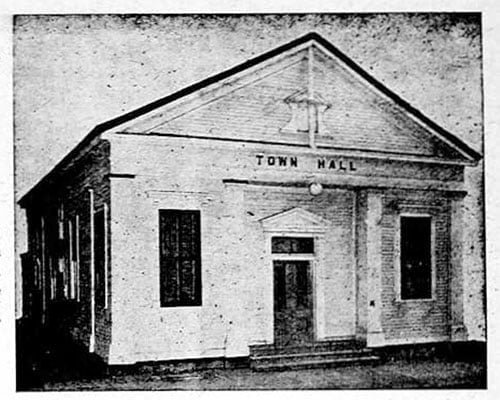
During the year R. D. Thomson, Town Clerk who had been in the employ of the Town for 13 years, resigned from that post to accept employment in private business.
The loss of such an efficient employee, and one who was held in such high regard by the Department of Municipal Affairs and leading Municipal figures throughout Nova Scotia was a serious blow to the Town.
Fortunately the Town was in the position of having a capable Deputy Town Clerk in Clifford A. Moir who was able to step into the vacancy resulting from Mr. Thomson’s resignation and who has since carried on in a well qualified and capable manner.
A full time tax collector in the person of Reginald Bonang was appointed during the year and he aIso served in the dual capacity as collector of public welfare accounts an d tax collector. As a direct result of his efforts; a marked increase was shown in collection of accounts.
Revenues for the Water Department stood at $132,423.49 during the year as compared to revenues of $128,978.10 in the previous year. All properties in the Dartmouth area are now metered and number approximately 3000. Gross surplus for the Water Department as of the end of the year stood at $43,362.82.
During the past year the Town put off the issuance or further debentures and as a result overdraft interest running as high as $1000 a month was being paid the bank. Purpose of delaying the Issuance of debentures was the higher rate of interest which would have had to be paid during that time because of the unsteady fluctuation of the bond market. This item alone contributed materially towards the over-expenditure experienced during the year.
During 1951 the Town purchased 214 prefabricated houses in North Dartmouth from Central Mortgage and Housing Corporation and permanized them with the installation of permanent foundation walls and other minor improvements. These were then offered for sale, first to the original tenants and then to eligible purchasers as they became available. The buildings were sold at prices of $2800, $3000 and $3200, depending upon the size.
The Dartmouth Park
Virtually all the efforts of the Dartmouth Park Commission in 1951 were concentrated in one section, the downtown corner of the Town Park bordered by Synott’s Hill and Park Avenue.
Chairman of the Park Commission Walter Meredith explained that the $2250 allotted by the Town to the Park Com-mission during the year was expended in this section, as the Commission felt this area was most often seen by motorists passing through Town, and most used by residents of the Town.
Construction of a lovely rock garden was the main project of the beautification program and this to date has met with considerable public favour. Due to the roughness and steep slope of this area it was decided that a terraced rock garden was most practical. Footwalks were cut through the garden and these were gravelled. Retaining walls were constructed and the whole area was planted with shrubs, many of which were donated by Towns· people and which helped greatly to beautify the garden. Other donations of suitable plants or shrubs will be accepted gratefully by the Commission.
Most of the money available was expended on labor and the remainder went towards providing grass seed, fertilizer and plants.
Regular maintenance of other Park districts, including upkeep of paths and driveways, was also continued throughout the year by the two man staff. Only tree planting undertaken in the Park during the year was a donation by the Dartmouth Lions Club in the form of a group of trees planted around the cenotaph in the centre of the Park.
During the year the Birch Cove property at the Dartmouth Lakes was turned over by the Town to the Commission and plans for beautification and clearing out of this area are now under consideration.
Public Health and Welfare
Increases in costs of hospitalization and medical care were responsible for almost half of the total amount the Town budget was over-expended in 1951. Of an estimated expenditure of approximately $21,000. total costs of Public Health and Welfare to the Town amounted to $31,125.90, a $10,000 increase.
Some of this amount is recoverable, but under the present legislation hospital debts incurred by Dartmouth residents are the responsibility of the Town for immediate payment, and the Town must collect payment from the persons responsible. Far example in 1951 total hospital costs to the Town amounted to $24,067.95 of which $5064.79 was recovered, leaving a balance of $19,003.16.
Grants to private charity organizations throughout the year totaled $3950. This amount was’ made u p of donations as follows: Victorian Order of Nurses $3000: Halifax Visiting Dispensary $200; Canadian National Institute of the Blind $200; Children’s Hospital $250 and Salvation Army $300.
Maintenance of inmates in charitable institutions during the year cost the Town of Dartmouth $6,266.47 of which $5,642 was expended at the Halifax County Home.
One bright spot , attributed to the relative prosperity of this area, was the fact that the cost of food, fuel and burial charges for indigents amounted to on1y $208.87.
Child Welfare investigations and ·work undertaken by the committee in the 1951 period cost a total amount of $Z773.95 including payment of $1943.77 to the Department of Child Welfare.
The polio epidemic which struck Nova Scotia last summer paid a visit to Dartmouth and sent a number of patients to hospital resulting in an unexpected expenditure in this field. The total cost of the epidemic to the Town of Dartmouth was $3742.85 of which $1197.40 has already been collected leaving a balance of $2545.45 uncollected, some of which is recoverable.
Medical Health
Medical Health in Dartmouth lost one of its Fathers in the death of the Town’s beloved Medical Health Officer Dr. H . A. Payzant.
Committee members, especially ‘appreciating the amount of time and effort the deceased had put into his work as Medical Health Officer in Dartmouth, have expressed their sincere regret in hi s passing. The Town Council meeting in a special session passed a special motion of regret at the passing of a man who had done so much to keep Dartmouth school children well, and the Town’s health at a high standard.
His efforts were centered around the work of the Victorian Order of Nurses in Dartmouth who achieved a great amount of work in Dartmouth schools during the 1951 period.
During the year the V.O.N. continued their educational program including Well Baby Clinics, School Nursing, Immunization Clinics and Health Supervision.
In 1951 the Nurses held 80 well baby clinics with 1353 babies examined. and advice offered. to mothers, 312 babies were immunized against diphtheria and whooping cough, while 132 were vaccinated. A total of 708 visits were made to babies in their homes for health supervision.
In the school nursing service provided by the V.O.N. the nurses checked 2867 children attending classes, having to exclude only 17 children for various reasons during the year. Defects discovered in various checks were reported to parents. A rapid inspection of all students was done three times during the year, while 90 children received free dental care at 7 dental clinics. 702 students were immunized against diphtheria, whooping cough and tetanus. 1500 students were given the tuberculin patch test with all positive re-actors and high school students being x-rayed by the MobiIechest x-ray unit. No active cases of tuberculosis were found.
Public Works Department
Expenditure of over $70,000 on street construction 2nd maintenance in 1951 highlight-ed a busy year for the Public Works Department. During the year a general policy of maintaining present good. streets and doing a small amount of new work was initiated with an overall plan which is hoped within the next few years to put all Dartmouth streets in good repair.
Of this amount approximately $10,000 was expended on an extensive patching program throughout the whole Town, designed to keep present streets from deteriorating as much as possible. The Town Engineer, J . Walter Lahey explained that many of the older Town streets are worn out and the Town is confronted with the same repair work year after year, until gradually these areas can be completely replaced.
After the patching program in 1951, came considerable construction of new streets. Included among those which received primer and penetration asphalt during that period were sections of Church street, Park Avenue, Thistle Street and Victoria Road, while complete jobs were done on Stairs, Howe and Wallace streets. In addition to this treatment, application of more material was given to the end of Haig Street, the upper end of Hester Street, all of Johnstone Avenue. all of Dustan Street, Fenwick Street, Rodney Road, Milverton Road, Murray Hill Drive, Blink Bonnie Terrace, part of Old Ferry Road, Newcastle Street, part of Maitland Street. Erskine Street, George Street, Bligh Street, part of School Street, Harris Street, Cairn Street, Graham, Murray and Francis Streets, and part of Crichton Avenue. Some street construction, in conjunction with sewer extensions was undertaken on Best Street which was reconstructed from Fairbanks Street to Shore Road, out of virtually solid bed rock. Catch pits were installed on Mott Street.
In addition to these, a considerable amount of time and money was expended in a tremendous improvement to the Prince Albert Road entrance to the town where a storm sewer was constructed in front of the MicMac club, and the street was repaved. This project, costing approximately $15,000, was financed half by the Town and half by the Province. There were no excessive snow removal costs in 1951, but from five to six thousand dollars was expended in sanding and salting streets. Three carloads of salt were put on Town streets using the new salt spreader, a modern piece of equipment purchased. by the Department during the year. It proved to be a most efficient and economical piece of machinery.
Other pieces of equipment purchased by the Town Works Department during the year Included the Hough loader at a cost of $16,000. This versatile piece of equipment proved exceptionally valuable to the Town and performed far more efficiently than anticipated. Complete with a snow plow attachment it was used for this purpose, as well as a bulldozer during the remainder of the season, and as a loader for both snow and earth. Another versatile piece of equipment was the self-propelled tractor compressor which was purchased in the Fall and was used in addition as a sidewalk snowplow in the winter. Dartmouth was a step ahead of most other places in the Province in purchasing this type of modern equipment but since their value has been proven locally many other areas have purchased the various new machines mentioned.
The long-overlooked drainage problem at the Dartmouth Park at the corner of Park Avenue and Commercial Street was solved during 1951 by the construction of a storm sewer up the side of the hill and across the Park to the juncture of School Street and Wyse Road. As a result of this work there have been no floods or wash-outs since, in this area.
Water and sewer extensions handled by the Works Department during 1951 included work on Milverton Road, Crichton Park Road, Clear View Crescent, Murray Hill Drive, and Victoria Road. A major undertaking during the year in this phase of the work was the commencement, and near completion, of a sewer installation up Prince Albert Road to Hawthorne, to connect with the Crichton Avenue sewer and aimed at alleviating a serious problem resulting from the small sized sewer originally serving this fast-developing section. This important installation will cost approximately $35,000.
The Windmill Road ·widening project, a plan which has been under consideration by the Town of Dartmouth since 1918, finally bore fruit in 1951 when property was acquired from residents bordering along the street to enable a wider street construction. The subsequent disposal of a building, and straightening of the street was undertaken but; due to a failure of the Provincial government to finalize negotiations covering the cost of paving the artery, this work had to be delayed until 1952.
An estimated two miles of curb, gutter and sidewalk were constructed in Dartmouth in 1951. Streets to. receive this attention included Johnstone A venue, Dahlia Street, Pine Street, and Wind:: mill Road (section Lyle Street to School Street). Due to the fluctuating bond and financial market the Department of Municipal Affairs advised against borrowing any further money for such work this year, although petitions for several more miles of work were on hand.
The newly purchased power lawn mower came in for considerable use during the summer especially on the new Memorial Park which was graded and seeded during the year. The Town undertook an extensive street cleaning program during the past year; several extra men were hired on to handle the street sweeping and washing, and all streets with curb, gutter and sidewalk came in for attention in this regard. Favourable comment on this was heard from all over Town.
Inauguration of a garbage pick-up system for the business district proved successful and this additional service was extensively used by the downtown business firms. Street lighting continued to improve. as new light fixtures were installed and new lights added.
Other highlights of a busy year for the Public Works Department included the construction of a number of catch pits; to reduce the possibility of floods on Town streets, and aimed at decreasing maintenance costs. This was a very necessary undertaking and fairly expensive. The aerial survey was completed during the y.ear and maps and plans turned over to the Town. Snow removal in the downtown business district, for the first time in history, resulted in additional parking space for patrons of downtown business places. This was done in a year of record high snowfall for the Town, a creditable achievement.
A number of new subdivisions in the Town were opened up and developed during the year, making way. for further residential development. Included among these was work in the new Murray Hill subdivision, Crichton Park subdivision, and the Hazelhurst subdivision.
Board of School Commissioners
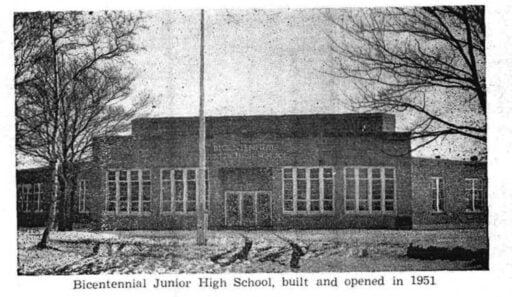
Rapid expansion and consolidation of school facilities through-out the Town, to keep pace with a fast increasing population of children partly from the influx of Naval families into this area, resulted in the Board of School Commissioners experiencing one of its busiest years in the Town’s history.
It was during this time that the Bicentennial Junior High School, costing approximately half a million dollars, furnished, was completed and put into use, and that plans were finalized for the construction of a new school building on the Notting Park campus as a replacement for old Victoria School, and to handle increased enrollment from this district.
Physical Assets
The Dartmouth school system is now composed of six schools Including the new Bicentennial Junior High, along with Hawthorn, Park, Findlay, Notting Park and the High School.
Latest addition to the school system, the new Junior High, is believed to be at least the equal, and in many respects the finest Junior High School in Nova Scotia. It has many assets such as a spacious auditorium, efficient household science and industrial arts rooms and large sized, well lighted classrooms which will stand Dartmouth in good stead in future years.
At the close of the 1951 Board meetings plans were well along for the construction of a new Primary school at Notting Park, to be connected with the present Notting Park building by a breeze-way.
Considerable progress was made in improving school grounds following a plan laid out several years- ago. Paving of sections at both Hawthorne and Findlay schools at a cost of about $6000 was the highlight of this phase of the work.
The fruits of a year of testing various light systems was seen in 1951 with the complete installation of fluorescent lighting throughout Hawthorne school. As a preliminary to this, a special test room had been installed at the school.
The regular program of painting and decoration throughout the school system was continued, keeping all property in a Good state of repair.
School Operation
In 1951 total cost of operations of the Dartmouth school system was $207,417.45 of which the biggest item, teachers’ salaries amounted to $129,291.
Of the total revenue the School Board received $152,660 from the Town general account while the remainder was made up in grants received from the Municipal School fund and mainly the Provincial government grants.
The total teaching staff amounted to 63 members including Supervisor of Schools Ian K. Forsyth. More than twenty-five per-cent of these teachers are men. Every effort is made by School authorities to select the finest teachers available, from the Province and beyond, to replace teachers who have retired.
In curriculum, especially the academic section, the high standard of teaching was maintained throughout. This is especially evidenced by the fact that when Dartmouth students wrote Provincial matriculation examinations their marks were well above the average for urban districts in the Province.
Thoroughly modern Household Science departments were set up and operated during the year at the new Junior High School with a staff of two trained instructors. This year for the first time. in the past 30 years a fun time Industrial Arts Department was established and operated at the Junior High. These facilities were made available, in so far as the Industrial Arts course is concerned, to Grades 7 to 10 inclusive and in the case of Household Science to Grade 11 as well.
In the field of physical education a program which has attracted interest throughout the Province was. carried out with two competent instructors employed. The field of music also saw two teachers employed, thus- enabling the teachers to inculcate the gift of song to all students.
There were a wide variety of extra-circular activities throughout the year, and one which attracted considerable interest was the Evening Vocational classes under the joint sponsorship of the Department of Vocational Education and the Board of School Commissioners which carried four adult classes in home sewing to a successful conclusion.
The other extra activities, including sports of all types, and inter House competition filled important niches in the school life and assisted the students in making themselves more valuable and efficient in future life.
Cemetery Committee
Continuing a long range program to improve Dartmouth cemeteries, the 1951 Cemetery Committee cleaned out a large section of the old Public cemetery (Park Avenue and Victoria Road).
All dead brush, trees and rubbish were cleaned out of this section and gravestones were straightened. Plans were laid for the seeding of this section in 1952. A section of property cleared of all’ rubbish and shrubbery in 1950 was loamed this year and then seeded, following the policy which will next year see the same action taken on the piece cleared in 1951. This sectional Work is planned to continue until the whole cemetery is completed, probably in 1954.
Some work was also undertaken on Mount Hermon cemetery where a low section was filled in, and a new Roman Catholic section opened above School street, approximately opposite Shamrock Drive. The roadways through the cemetery were leveled and the road edges trimmed back to provide a 16 foot driveway. Some small trees and perennials were planted and this beautification plan will continue.
To continue this work and still keep the cemetery self-sustaining it was found necessary to increase both lot rates grave opening charges in 1951.
Water Committee
Undertaking of one of the greatest water system improvements ever seen in Nova Scotia be-came a realization in Dartmouth in 1951 after a number of years of planning.
After ratepayers of the Town had voted $700,000 for this important project, immediate action was taken to commence the proposed plan laid out by the Engineering Service Company of Halifax and this firm was retained by the Town to supervise the project.
During the year an enormous reservoir, capable of holding more than five million gallons of water was gouged out of the top of a hill 375 feet above sea level. An extensive pipe line system to carry this high gravity pressure supply of water into the higher sections of the Town was installed, including 14,000 feet of 24-inch pipe and 1300 feet of 16-inch pipe, to bring this new supply of water to the Town boundary. This main will connect with the new -water system laid in the Town during the past year and will help to serve these higher level customers. In reality, when this project is completed and in use sometime this coming summer, the Town will be provided with two complete and independent water systems.
Mr. John Kaye of Engineering Service Company has reported that costs for the project have run very close to the original estimated amount of $700,000 but he believed that the total cost of the project would not exceed this estimate.
This includes the purchase of property on which the reservoir is situated, plus considerable watershed area, also the cost of purchasing and installing almost three miles of pipe line, plus the construction and equipping of a modern pumping station at the water source, Lake Lamont.
The main water project, including excavation of the reservoir and laying of the pipe, has been handled on contract by the Atlantic Construction Company, while the pump house is being Constructed by Foundation Maritime Limited. Spokesmen for the Engineering Service Company have told the Town that the new system will probably be filled with water early in the summer at 1952 but actual use of the water by the Town will depend upon the length of time .it takes the mud and sediment to settle from the water in the reservoir, and also upon how many leaks are discovered in the more than three miles of newly laid, and yet untested water mains.
Routine Operations
The routine operation of the Town’s water system continued as usual in 1951 wit h very few major breaks or similar problems arising during the year, according to Town Engineer Walter Lahey.
Total revenues received by the Water Committee during the year from sale of water amounted to $132,482.49 as compared to $128,978.10 during the year 1950.
Throughout Dartmouth itself all water was provided on a metered basis,· as was all water sold to the Municipality of Halifax County, or other outside purchasers. The gross surplus for the Water Department for the year stood at $43,362.82 according to figures provided in the financial statement.
Public Safety Committee
Laying the preliminary groundwork for the Civil Defence organization in Dartmouth, and attempting to educate the public in the importance of this work proved to be one of the most important undertakings of the Public Safety Committee in 1951.
Appointment of Mr. J. J. MacIntosh as Director of Civil De-fence in Dartmouth, and organization of a committee which included responsible and civic-minded men in the Town was successfully undertaken and the nucleus laid for a sound Civil Defence group.
As in 1950, the Public Safety committee again in 1951 directed the operations of both the Town Police and Fire Departments. Combining of both Forces under one central direction proved. highly successful and avoided duplication of plans.
The committee expended much effort and time in 1951 drafting out plans for a metered parking lot in the downtown area on Commercial Street opposite the Dartmouth Ferry. It was decided to recommend that several old buildings on Commercial and Portland Street, owned by the Town, be torn down to make way for a 32 car parking lot. It was proposed that the parking lot be graded and paved to provide a permanent parking area.
Considerable study was given to the traffic problems in the downtown business area and it was recommended to Council that four sets of traffic lights be installed. Consideration of the proposed extension of a new artery, to provide a new route for through traffic connecting with Newcastle Street on one end and Commercial on the other, was also passed on to Council.
A new Police car was purchased, and three men were taken on the Police force, two as replacements, and one new man, to strengthen the force. There was no increase of men in the Fire Department. In both of these Forces a salary scale was established, with a minimum of $1900 and a maximum of $2300 for regular Firemen and Police constables.
A big step was taken when all the Union Protection Company equipment was moved to the Fire Station. Now all equipment, including clothing and truck, is housed in the new Fire station building.
There were no major expenditures in the Fire Department, except for the purchase of a 35 foot aluminum ladder thus completing a full set of ladders on the ladder truck, replacing all the wooden ladders of the Department.
A breakdown of activities and expenditures for each Department follows:
Fire Department
The high standard of efficiency in the ·Dartmouth Fire Department, under the direction of Fire Chief George Patterson, was maintained during 1951 when the Department responded to 189 alarms. Total fire loss during the twelve month period was $28,512. of which $23,372 was covered by insurance, and $5140 was uninsured.
This fine record was accomplished with a force composed at 40 volunteer firemen and ten regular men, including the Fire Chief. Total expenditure for the Fire Department in 1951 amounted to $69,255.75 of which the biggest item, $39,000, covers the cost of providing water for fire fighting and also provides funds for the installation of fire hydrants and connections. Actual cost for operation of .the Department amounted to $30,255.75.
Police Department
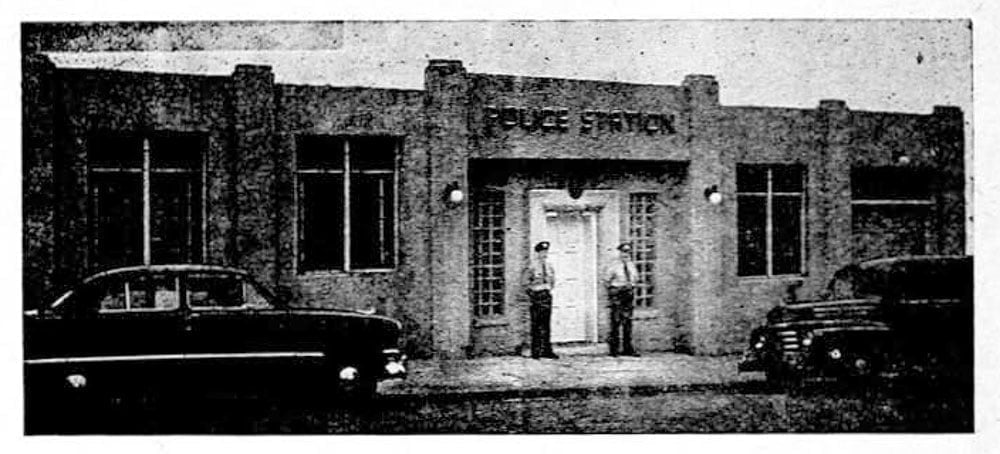
Under the leadership of Police Chief John Lawlor, the Dartmouth Police Force had a busy year during 1951 with increased traffic patrols, and checking on traffic violations in the downtown area, taking considerable extra time.
A considerable number of hours was spent in actual traffic direction during the past year, accentuating the early need for installation of traffic lights. The regular Police Force in 1951 was composed of 14 men with a Reserve force of 25.
A total of 539 cases were taken before Police court during the 12 month period, with a total of 496 convictions. Six offenders were sent over to County Court and two went before Supreme Court, with two convictions resulting.
In addition to regular duties a total of 1386 complaints were received and investigated during the year, with a total amount of $3380 in fines being collected, along with $1904.75 in costs.
A new patrol car was placed in use during the year.
Recreation and Community Services
The development and promotion of sport for the youth of the Town, aiming towards the successful development of sound future citizens, was accentuated in endeavours pursued by the Recreation and Community Services committee of the Town in 1951.
The efforts of the committee were also turned towards the development of the D.A.A.A. grounds and ball park, with a view to milk:n g necessary improvements in this valuable property so that residents of the Town could continue to enjoy top flight baseball on a field comparable to any east of Montreal. Negotiations were undertaken with officials of the Arrows Ball Club wit.h a view to negotiating a satisfactory lease for the Park.
Baseball was also highlighted in efforts to construct and grade out a ball field for the smaller youngsters, at the foot of Summer House hill in the Town Park.
Approximately $300 was expended at the Commons field in re-surfacing the field, and also for the erection of the backstop and construction and repairs to bleachers. Considerable work was done on the playing field here with a view to improving its condition for use by pupils from the “Bicentennial Junior High School, which is located nearby.
The public swimming pool at the corner of Commercial Street and Park Avenue, a mecca for youngsters of all ages, was patronized even more than usual in 1951. To encourage use of the facilities provided here by the Town for the benefit of the community the committee had both the swimming and the wading pools completely re-cemented and put in good condition, They were also disinfected to ensure safe, clean bathing for the children. Again this year two supervisors, one male and one female, were in charge while the pools were in operation between Dominion and Labor Day. A large number of children was given instruction in the principles of Water safety with a number receiving Red Cross swimming badges.
One of the most important community services coming under the direction of this committee during 1951 was the Tourist Bureau operated throughout the summer months by the Dartmouth Junior Board of Trade. Efforts were made to landscape the property and the complete program here w ill be completed next year.
Painting of benches and general maintenance and upkeep of grounds in Victoria Park was another committee effort, together with general maintenance in Wentworth Park. These areas are important to the Town with the rapid residential growth of the past few years.
An important service provided partially through the efforts of the committee, the Dartmouth Public Library, has again proven its value to the cultural and educational background of the Town. Attendance more than doubled the population of the Town in 1951 with 29,906 persons visiting the library while circulation reached a new high of 32,778.
Town Planning Board
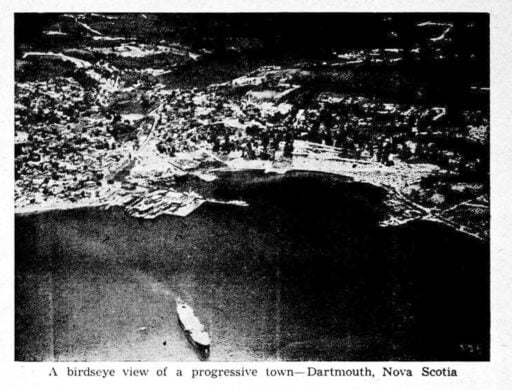
Completion of the revised building by -laws and their enactment by Town Council was one of the main accomplishments of the Town Planning Board in 1951. They are now available in convenient book· let form to the general public for a fee of $1. They provide a more up-to-date building code for what has proven to be tremendous development in the building field in Dartmouth during the past few years.
Construction of single dwellings remained at a high peak in Dartmouth during 1951 although the total building figures in that period dropped slightly over the previous year. Total value of building permits issued in the year was $949,963, almost one million dollars.
Of this amount two thirds, or $618,832, accounted. for single dwellings for which a total of 73 building permits was granted. During the year also permits were issued for 38 apartments, com-posing a total value of $51,300. Continuing their trend towards improving the appearance of the Town’s business district, various merchants applied for applications to remodel store fronts with a total estimated! value of $15,500.
Biggest individual building permit granted during the year was to Dominion Stores Limited for a master market on Canal Street at a total estimated cost of $80,000. Other big items include the $30,000 expansion of the Dartmouth Medical Centre; construction of the Woolworth store valued at $50,000; and a number of minor items including a $20,000 service station construction, and consider-able work in alterations and additions.
Some consideration was given to the laying of a groundwork for the preparation of Zoning by-laws to be used in conjunction with the new building by-laws, and it was decided to pass this item on for action to the incoming Planning Board.
Dartmouth Rink Commission
A new era in the sports development of Dartmouth was herald-ed in 1951 with the official opening and operation of the Dartmouth Memorial Rink.
Authorized by vote of the ratepayers in 1950, the $175,000 structure, located virtually on the same site as the old Mar k-Cross arena, fills a long-felt need in the Town. Built of permanent type materials, including brick tile, and especially designed structural steel the new building came in for a terrific amount of use during the Spring of 1951, just after it opened, and during the Fall and Winter season to follow.
Actual opening date of the beautiful new rink was slated for early in January but due to delays experienced in the installation of the freezing equipment this was held back until February when at a special ceremony Han. Geoffrey Stevens, M.L.A. officially tossed in the first puck to open operations.
Included among the varied activities to take place at the ice palace in 1951 were the operation of a large number of hockey leagues, ranging all the way from midgets and bantams up to the participation by the Chebuctos in the Valley Hockey League. Other promotions held at the rink included the Dartmouth Kiwanis Club’s Ice Follies show which promises to grow bigger each year, plus numerous public skating sessions, and rental of ice to private parties and firms. During the year every effort was made to insure provision of skating session and hockey time for the younger children and this is expected to increase annually through the efforts of such organizations as the Dartmouth Minor Hockey Association headed by Colenso Bowles.
Financially, during its first year of operation the Rink showed an operating profit of $142.48. This is before payment has been not in full operation during that period, this profit might not have operated only for a portion of a year, and the leagues, and such attractions which would bring money into the Rink coffers were not in full operation during that period this profit might not have. been as large as hoped for but this situation is expected to improve following a complete year’s operation. Rink Commission members were confident of a successful operation, especially if arrangements can be completed for a permanent type flooring to be laid over the brine pipes so that the Rink. building can be used for special money making attractions during the summer months. Arrangements are now underway in this regard.

The Reassessment Survey
While it may not have been the major undertaking of the year. 1951’s general reassessment survey in Dartmouth will have a far reaching influence on the Town’s financial structure for years to come, and will serve one of its main purposes in seeing that each citizen pays a just and equitable portion of taxation.
In the words of the Assessment committee composed of Chairman James L. Harrison and members, Mayor Claude H. Morris and Deputy Mayor D. T. Marsh, this is what was done:
“The Assessment committee in 1951 was composed of the same personnel who in 1950 had studied assessment procedures in Dartmouth and had recommended a complete overhaul to ensure a modern and equitable system.
The committee reported in part- “In order that each citizen pay a just and equitable portion of taxation, complete revaluation should be carried out in Dartmouth – – – a person familiar with modern assessment systems and procedures should be engaged to completely overhaul our assessment department – – -this supervisor should prepare the various tax maps, the necessary records and forms, the proper scales and tables of land and building values, and from the co-ordination of these and actual physical measurements, arrive at the goal of a scientific appraisal of all properties in Dartmouth.”
During the past year a revaluation and reclassification of all property was undertaken with a modern system of assessing and recording instituted.
Mr. M. E. Mullan was engaged at a salary of $4500 to organize, supervise and conduct the reassessment. Mr. Mullan has had experience in the construction field and in assessment work in Ontario and had recently been engaged in reassessment work in Halifax County.
In commencing the reassessing in Dartmouth, the Town was divided into sixteen pricing zones for the purpose of evaluating land in different sections of the Town. In the downtown area a lot with a 40-foot frontage was taken as the standard; in residential areas a lot 50 by 100 was decided upon as a standard. A system of graduated plus and minus factors was set up to provide for wider, deeper, narrower and shorter lots, and formulae were set up to calculate values for unevenly shaped or extraordinarily situated lots. Minus factors were also applied to land assessments to allow for lack of pavement, sidewalks, water or sewer, and other physical conditions.
Valuations on buildings were calculated from reproduction costs obtained by co-coordinating physical measurements with costs of material and labor and allowing for depreciation and condition factors. Other factors influencing the building value that were taken into account were: type of heating plant and plumbing; particulars of interior and exterior construction and finish, plus unfavorable exposure influence, such as proximity to railway and fire stations, cemeteries, old buildings and undue noises.
“A field sheet was designed with sections for recording all information dealing with the land and building values and showing each step in arriving at each individual assessed value.
“An assessment manual for the use of our Assessment Department was drawn up with all formulae and factors included as well as a schedule of rates for personal property.
“During 1951 the sum of $13,259.57 was expended on the re-assessment work.
“In 1952 the various Tax Maps will be completed and toe remaining details of the survey cleaned up. A study will also be made of alternate methods of assessing personal property and applying poll taxes.
“Your assessment committee is confident that completion of the reassessment work will result in equitable and just distribution of the tax’ burden among the ratepayers.”
The Dartmouth Ferry

With total assets less accumulated depreciation standing at $983,377, almost one million dollars, the Dartmouth Ferry Commission could look over the past year as one of consolidation, in which a policy aimed at keeping the Town-owned industry on as sound a financial footing as possible, had been successfully pursued.
The Dartmouth Ferry Commission is keeping a close watch on its immediate future plans, and the effect on its vehicular and possibly pedestrian traffic when the Halifax-Dartmouth Bridge is completed. At the annual meeting it was decided to increase the rate of depreciation on a number of items, so as to leave the Ferry as free of debt as possible in case a changeover should become necessary.
The annual financial statement of the Ferry at the conclusion of 1951 showed an operating profit on the year of $9284.92 which was turned over to the Town of Dartmouth according to statute. It also revealed that total financial revenues from ferriages during the same period amounted to $531,440.81, the second highest recorded in the history of the Town.
Gross revenue for the year totaled $536,683.02 a total second only to 1950’s revenue. The highest number of pedestrians carried on Dartmouth ferries since the peak year of 1944 used the service in 1951, a total of 4,585,218. The second highest number of motor vehicles also used the facilities in 1951 with 551,423 being carried across the Harbor. Last high was in 1950 when 561,076 vehicles were transported.
The importance of the Dartmouth Ferry operation to the economic stability of the Town is accentuated by the fact than in 1951 almost quarter of a million dollars was paid out of revenue for salaries and wages of employees. Actual total was $227,206.18 In addition to this Dartmouth merchants and business men benefited directly to a consider able extent. by the approximately $70,000 expended for operational purposes with Dartmouth business firms.
Another direct contribution made to the operation of the Town by the Ferry was the payment of $30,531.63 covering taxes and water rates in 1951.
The Commission’s fixed assets were increased during the period. by $5824.54 covering improvements to the main dock in Halifax. with reductions of $46,898.56 due to the sale of the steamer S.S. Chebucto to Upper Canadian interests for $5000 leaving a balance on fixed assets as of December 31, 1951 of $1,141,470.46.
The Ferry’s debenture debt at the end of 1951 totaled $246,500. which amount is being retired by annual payments from revenue.
As the result of unusually heavy repairs on the ferry steamer S.S. Halifax a portion of the cost of repairs, $28,345 was charged against the unforeseen contingencies reserve fund leaving a balance at credit of $134,854.03. The financial report of the auditors shows an underappreciated balance on boats and property of $362;220.01 with provision made in 1952 for depreciation of an amount totaling $44,834.



